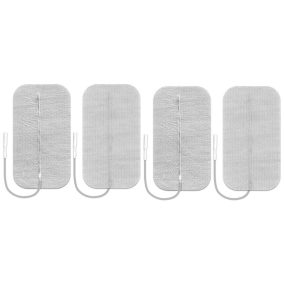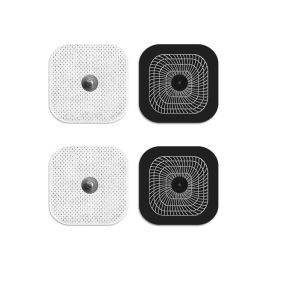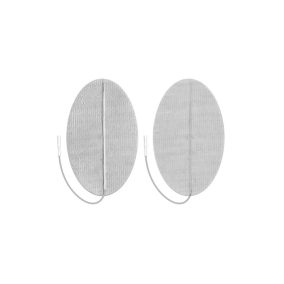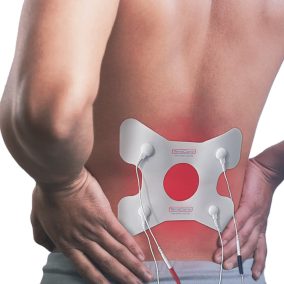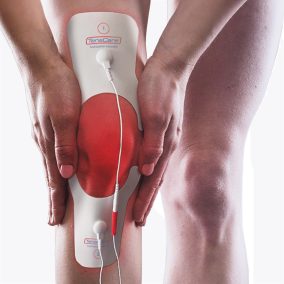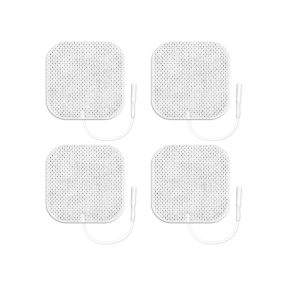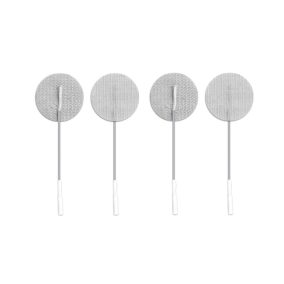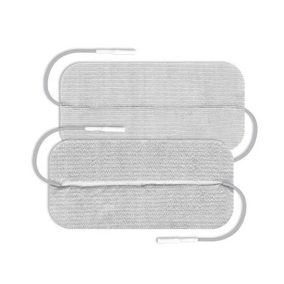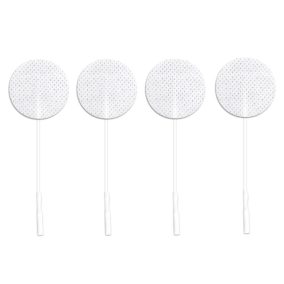The TENS electrode is an essential accessory for home electrotherapy treatments (TENS - nerve stimulation, pain relief; EMS - muscle stimulation; Microcurrent - pain relief and healing promotion). The impulse passes from the device to your body through the self-adhesive "pad" attached to the skin. Without it, there is no treatment and no effect.
In this video, Dr. Zsolt Zátrok summarizes the most important information to help you choose.
The TENS electrode is a consumable which wears out over a few treatments and needs replacement! (like gasoline in a car – the more you use the car, the more often you need to refill the tank).
Additionally, the TENS electrode is a hygiene product, so opened packages cannot be returned (just like you cannot return an opened tissue pack).
Standard Compliance
Our company distributes electrodes and devices compliant with the European Union Health Standard! Electrotherapy devices and self-adhesive electrodes shown in the webshop are compatible with each other.
WARNING!
Some health and wellness device manufacturers (e.g., Omron, Beurer, Vivamax, Bluidea, Kentro, Aldi) often use non-standard connectors on their devices. Standard electrodes available from us usually do not "fit" these.
This is a marketing tactic by these manufacturers. They sell the devices cheaply, but spare electrodes are either unavailable or cost 8-9 thousand HUF. If you need to use the device regularly, this makes the use much more expensive.
Larger, medical-grade manufacturers generally use standard PIN or SNAP connectors, so you can connect any standard PIN or SNAP electrode to them.
Before purchasing a device, ensure that spare electrodes are available and that the device is suitable for medical use.
Main features of the TENS electrode
- Connector type (pin, snap, clip, other)
- Size and shape (square, rectangle, round, oval, other)
- Layers (cover, gel, conductive layer, adhesive)
- Usage (single-use or reusable)
- Conductivity quality.
Connector Type
Electrotherapy device cables generally have
- pin (PIN) or
- snap (SNAP) or
- other non-standard connectors.
Size and Shape
You can find a great variety of sizes and shapes on the market. The most common forms and sizes are
- square (4x4 or 5x5cm)
- rectangle (5x9 or 5x10cm)
- circle (2.3, 3, 5 cm diameter)
- oval (3x5, 7.5x13 cm)
- butterfly and other shapes.
When choosing size, consider the area to be treated! Obviously, a 7.5x13 cm oval electrode pair won't fit your face; instead, round electrodes of 2.5 - 3 cm diameter are appropriate. On your calf, the larger 7.5x13 cm oval electrode is better. For general pain relief (TENS or microcurrent) treatment, 4-5 cm square electrodes are suitable. I recommend the same for stimulating muscles of the neck, shoulders, arms, and motor points (larger muscles: thigh, abdomen, chest, back). For muscle stimulation, I suggest the 5x9, 5x10 cm electrodes as the farther electrode from the motor point. Keep in mind that for stimulation, 2mA/cm2 current is generally recommended. A 5x5 electrode covers 25cm2, so the recommended maximum current is 50mA. The smaller the electrode, the smaller the area the current concentrates on. Higher current can cause more discomfort.
Layers and Materials
The materials and thickness of the electrode determine its flexibility. The thicker and stiffer the electrode, the less it conforms to body contours.
Cheap electrodes usually have three layers: adhesive, gel, and cover. The current is conducted in the gel layer, which distributes it. Higher quality electrodes (types: PALS, Ultrastim, ValueTrode) have two gel layers, adhesive, conductive layer, and cover. The double gel layer provides more even current distribution, reducing unpleasant stinging sensations. The cover layer is typically textile, foam, paper, or special material.
Thicker and stiffer electrodes fit well on larger muscles (thigh, back, abdomen, buttocks). However, they are unsuitable for thin wrists, neck, etc., where strong curves require flexible electrodes.
Cheap (usually Chinese) electrodes are stiff and curl at edges on bends, causing poor contact and concentrated current, leading to uncomfortable treatment. PALS electrodes represent the highest standard. They include stainless steel mesh, are extremely thin and flexible. The full-area mesh ensures perfect current distribution. UltraStim electrodes use silver fiber mesh for conductivity, also excellent but somewhat stiffer. ValueTrode electrodes, intended for general use, have no conductive fibers; the current flows through the double gel layer, providing good distribution but making the electrode stiffer.
How to Choose Electrodes?
Electric impulses trigger the desired response in your body only if the intensity (current strength) is appropriate. The higher the intensity, the more uncomfortable the sensation. Above a certain current, pain prevents continuing treatment.
If the electrode is poor quality, it has low conductivity. High current must be set on the device to achieve effect, increasing discomfort. If current is too low, no effect occurs.
A better conductive electrode delivers appropriate impulses at lower current, enabling more effective treatment.
Buy Chinese electrodes only if you want to train yourself as a fakir. Poor quality electrodes guarantee unpleasant and ineffective therapy.
Generally, if possible, choose the best quality: PALS electrode. If price matters, proceed as follows.
For pain relief (TENS and Microcurrent) treatments:
Generally, ValueTrode electrodes suffice. For TENS and Microcurrent, 40-50 mm diameter electrodes are suitable. Place them around the pain area for stimulation.
For Bell's palsy and facial aesthetic treatments:
Small diameter electrodes (25-30 mm) are needed for face and neck, as muscles are small and space does not allow larger electrodes with some cm gap between them.
I recommend the 32mm ValueTrode Round or 25mm PALS Round electrodes for the face.
For denervated (paralyzed muscle) treatments:
Damaged nerve is sensitive. The better quality the electrode, the gentler you are to the nerve. It is advisable to use PALS or UltraStim electrodes.
Depending on the muscle, you can use 25-32 mm round electrodes (e.g., facial nerve paralysis) or 5x5 and 5x9 cm (peroneal paralysis), etc.
For muscle stimulation treatments:
There are two schools of thought about recommended electrode size for muscle stimulation. Some recommend larger electrodes; others suggest using various sizes.
Proponents of larger electrodes argue that the bigger the electrode, the easier current spreads through muscles, the higher the comfort, the higher current intensity achievable, and the stronger the muscle contraction.
Opponents believe the smaller electrode should be placed on the muscle belly (usually protruding part). Smaller electrodes concentrate higher current on the motor endplate (motor nerve), located at the center of muscle. They also say smaller electrodes reach deeper parts of muscle before the nearby other electrode affects them.
I recommend trying both variations and deciding which feels more effective based on experience.
| PALS | UltraStim | ValueTrode | Cheap-anonymous | |
| Number of uses | 15-20 | 20-25 | 15-20 | 5-10 |
| Gel layers | double | double | double | single |
| Conductive fiber | stainless steel mesh | silver fiber mesh | none | none |
| For TENS treatment | Excellent | Excellent | Excellent | Acceptable |
| For MENS treatment | Excellent | Excellent | Acceptable | Poor |
| For muscle stimulation | Excellent | Excellent | Acceptable | Acceptable |
| For denervated treatment | Excellent | Excellent | Acceptable | Not suitable |
| For facial nerve paralysis | Excellent | Excellent | Acceptable | Not suitable |
| Retention of shape | Flexible | Stiffer | Stiff | Stiff |
I made a video about self-adhesive TENS electrodes. Watch it and subscribe to my YouTube channel! Don't forget to click the bell icon to get notified about the next episode!
You can extend the lifetime of the self-adhesive TENS electrode (pad) with careful use
Electrodes received with your device can be reused from a few treatments up to 20-30, depending on quality. Eventually, they stop sticking, dry out, and fail to deliver impulses properly. Then you must buy new electrodes, which means recurring costs if you frequently use the device.

- Electrodes are shipped attached to a plastic sheet.
- Carefully peel them from the sheet. Avoid touching the adhesive as it reduces stickiness.
- Ensure the adhesive side does not touch the floor or clothing, as dirt quickly reduces adhesion.
- Before applying to skin, wash the treatment area with warm soapy water (degreasing) and dry thoroughly. Only apply electrodes to completely dry skin.
- After use, peel off from skin in one motion and immediately stick back to plastic sheet for storage. Do not pull by the cable; it may cause damage!
- Store electrodes in the refrigerator (not freezer) to extend lifespan.
- If electrode surface looks dry, drop a little water on it to gain a few more uses.
- When the electrode no longer sticks, you can extend life by using contact gel and tape.
- Don't do this for too long, as dry electrodes do not conduct impulses well, reducing treatment effectiveness.
- Eventually, you must replace the self-adhesive electrode with a new one.
Following these tips will maximize electrode lifetime and treatment effectiveness while optimizing costs.
Can self-adhesive electrodes be replaced?
If you want to avoid recurring expenses, you can use "permanent" electrodes. These are usually made from rubber-carbon-silicone materials, almost indestructible and usable for years. They are not sticky or gelled. You need velcro straps or tape (e.g. leukoplast) to fix them in place. They cannot be used dry; contact gel is necessary to conduct impulses to your skin (without gel, treatment will sting).
- You can choose specially designed large-surface electrodes for abdomen-buttocks-thigh treatment (FastPads, Flexible electrode set).
- You can simplify waist and abdominal muscle treatment with electrotherapy belts (FastBand belt, UltraStim Belt).
- For muscle stimulation, you can use silicone-carbon electrodes.
- Incontinence can be treated with vaginal and anal probes.
- Ionotophoresis uses sponge-covered carbon electrodes.



